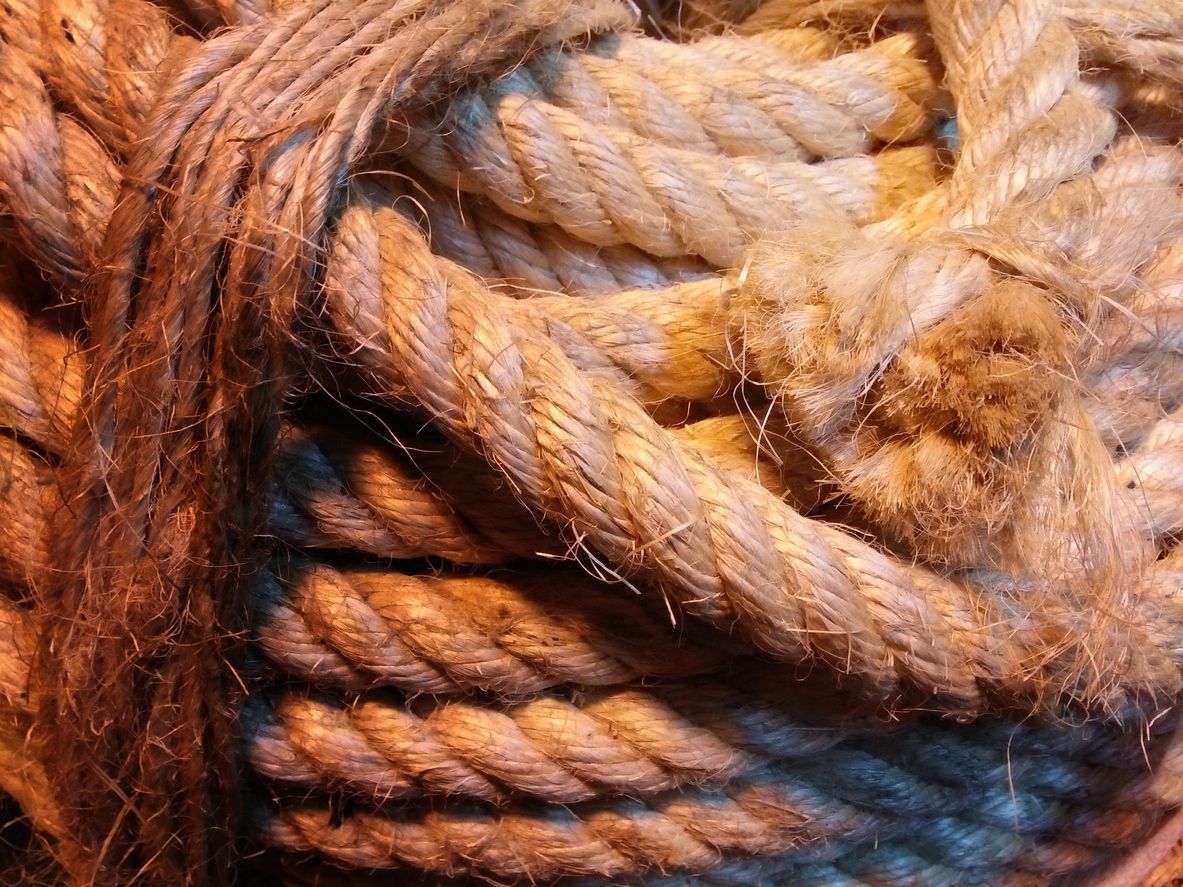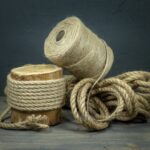Manila rope is a natural fiber rope from the abaca plant in the Phillippines. Out of all the natural ropes, manila is one of the strongest and most durable. Sailors used it on ships for centuries because of its resistance to saltwater damage.
The Phillippines remain the primary farming location of manila. Machines still need to perfect the process, so farmers still collect and strip the fibers by hand.

For centuries, manila rope was most commonly used on boats and ships. Today, it’s not as common to use natural fiber ropes on vessels. Yet, some boaters with smaller vessels still prefer them. Manila rope is also great for fishing, exercising, decoration, and utility contracting.
You’ll want to consider its properties to ensure your manila rope lasts as long as possible. What is the breaking strength of your manila rope, and how can you handle it safely? How can you cut it while avoiding fraying? How can you soften your rope for more manageable handling? Check out the guide below, where we answer these questions.
Consult the table we’ve prepared below to compare manila rope with other natural ropes.
What Is Manila Rope?
Manila rope comes from manila hemp, a long fiber from the abaca plant’s leaves. The Phillippines is one of the world’s major producers of the abaca plant. The fibers get their name from Manila, the capital of the Phillippines.
Manila hemp is not really a type of hemp. Rather, it gets its name from hemp because it’s one of the most popular plants used to make fiber.
Manila Rope Properties
Manila ropes are one of the best natural ropes to use. They are flexible, durable, and resistant to saltwater damage. Rope users favor manila for its ability to be flexible without stretching.
During the production process, laborers soak manila rope in water. Manila, and other natural ropes, shrink when wet. Yet, they shrink the most the first time they get wet.
A manila rope’s length shrinks by about 10-15% the first time it gets wet. Conversely, the diameter of a wet manila rope actually increases.
Shrinkage significantly decreases each time the rope gets wet afterward. Soaking the rope during the production process is beneficial to the consumer. Manufacturers reduce the amount the rope will shrink when actually in use.
Despite its resistance to water damage, you should avoid getting your manila rope wet. Enough exposure to wetness will eventually cause your rope to rot. After exposure to saltwater, boaters should rinse the ropes with fresh water. Rinsing away the salt will prolong the life of your rope and stave off rot.
Moisture also causes extra stress on your rope. It tightens knots and makes them difficult to untie. Still, some boaters prefer the tightness of the knots because they are unlikely to slip while in use.
The History Of Manila
The use of manila rope has been around for at least 4,000 years. The ancient Egyptians used the ropes on their boats.
In the 1800s, manila rope became very popular with whaling ships and other tall ships. They used manila rope to make climbing ropes to reach the bird seat high up at the top of the ship. Bird seats were areas where sailors could sit and act as lookouts on their boats.
Sometimes, the sailors even used the nets for climbing contests when they got bored. Those that could climb the highest the fastest won bragging rights. Sometimes, they even won money that they’d bet.
From these sailor’s games came the use of climbing nets in the U.S. Marine Corps and, later, the Army. Soldiers used the nets for training, though, not for playing games.
Manila rope was the most common material used for hanging-style executions. Both the United Kingdom and the United States used manila rope for their executions.
How To Make Manila Rope
Most of the manila-growing farms in the Phillippines are still family-owned. The farms are small operations. In Ecuador, manila farms are much larger in scale and are owned by cooperations.
Machines still can’t harvest manila fibers. Laborers must still harvest by hand — a painstaking process. After harvesting, they must strip each stalk into thin pieces. Then, they scrap each thin strip, separating each fiber strand.
Next, they wash each fibrous strand and drape it over a thin line for drying. Once the strands are dry, they are baled into large balls. Lastly, they are shipped to manufacturing plants. There, the fibers are braided and twisted into rope.
Manila Rope Breaking Strength
Do you want to know the strength of your rope? First, you must understand the difference between tensile and breaking strength.
Tensile strength describes the load under which a brand-new rope may break. These ropes go through tests in controlled, laboratory environments. So, the tensile strength is not an accurate measurement of when a rope will truly break.
The breaking strength also describes the load under which a rope will break. Yet, the breaking strength considers outside forces. It considers whether the rope gets wet, if there are knots, if there is any fraying, etc.
Manila rope is one of the strongest natural ropes. Still, you’ll want to know the breaking strength of your rope before using them.
Consult the chart below to see the estimated breaking strength of manila ropes.
Minimum Breaking Strength Of 3-Strand Twisted Manila Rope
| Diameter (Inches) | Minimum Breaking Strength (Pounds) |
| ¼ | 405 |
| ½ | 1,788 |
| ¾ | 3,645 |
| 1 | 6,075 |
| 1-¼ | 9,112 |
| 1-½ | 12,487 |
| 2 | 20,925 |
Precautions
Braided manila rope is stronger than plaited or twisted.
Plus, the breaking strength is not a firm number, and the true breaking strength varies with each rope. It’s always best to work well below your rope’s breaking strength. Doing so prevents the rope from failing and putting you in danger.
How To Cut Manila Rope Without Fraying
Cutting your manila rope in a way that prevents fraying will save you a lot of trouble in the long run.
Follow these simple steps to cut your rope:
[1] Grab your supplies
- Sharp knife or a pair of loppers for ropes with a large diameter
- Don’t use scissors as they cause fraying
- Electrical tape
[2] Pick the spot you’re going to cut through
- Avoid areas that are loose, squishy, or frayed
[3] Wrap a length of the electrical tape around your chosen cutting spot three to four times
- Wrap the tape as tightly as possible
- Your layers of tape should slightly overlap one another
[4] Cut through the middle of the taped section
- Hold the rope with your non-dominant hand
- Make a smooth cut with your dominant hand
[5] The cut is complete
How To Keep Manila Rope From Fraying
Most manila rope is treated with mineral oil. The oil prevents them from becoming brittle and fraying. Still, the oil will not prevent your rope from breaking down indefinitely. Untreated manila rope is less durable, though, and is more prone to fraying.
One of the best ways to keep your rope from fraying is to tape the ends. Use electrical or duct tape to wrap around the ends of your rope. Place a wide and flat piece of tape over the end of your rope. Begin wrapping the tape’s ends around the ends of the rope.
Another similar option is to “whip” the ends of the rope with some whipping twine. You’ll create a whipping knot around the end of your rope to cover the fraying and prevent further fraying.
How To Soften Manila Rope
Rope softens over time with natural use. Still, for certain activities, you may want to pre-soften your rope before use. You can use these methods with other natural ropes as well.
Here are a few ways to soften your rope:
Breaking
You can manually break the hardest fibers of your rope to make them more flexible. Use a carabiner to hang your rope, and twist it around itself three or four times. Apply a “seesaw” motion across the length of the rope to make it more flexible. The more you do this, the softer your rope becomes, but it also becomes weaker.
Singeing
Singeing removes chemicals from your rope and can eliminate annoying fuzzies.
You’ll need an open flame, like a lighter or gas stove. Avoid candles as they leave soot on your rope. Run your rope through the flame continuously until there are no more fuzzies. Clean your rope with a damp cloth afterward.
Wet Treatment
Getting your rope wet will remove some of the chemicals and make it softer and more flexible. Wet treatments are suitable for manila rope since it is resistant to water damage.
You can perform a wet treatment with or without soap.
The first method is to add your rope to a boiling pot of water. The longer you boil, the more flexible your rope becomes.
The second option is to run your rope through your washer. Place it in a mesh laundry bag to prevent tangling.
Thirdly, you can run the rope through the dishwasher. Using the dishwasher is convenient because it prevents tangling.
Afterward, dry your rope under tension, so it doesn’t kink, shrink, or deform. Pull the rope between two points until it is tight. You’ll need to retighten the rope as it dries.
Mineral Oil
Adding oil to your rope helps it stay healthy and prevents it from becoming brittle. Place oil in your hand or on a rag, and run it over the length of your rope. You can also add some wax to the oil to make a small cake that you run along the length of your rope. The wax will make your rope slicker.
What Is Manila Rope Used For?
Throughout history, manila rope was most commonly used on boats and ships. Today, the use of manila rope on boats is less common. Still, it is sometimes still practiced, particularly on smaller vessels. It’s also useful for fishing, exercising, decoration, and utility contracting.
Boating & Fishing
Due to its saltwater-resistant qualities, manila rope is commonly used on boats. Boaters use them as hawsers for towing or mooring their vessels. They also work well for fishing nets and ship lines. Natural ropes are not used as often today with the invention of synthetic rope materials. Still, manila remains one of the most popular natural ropes used on boats.
In the 19th century, manila rope was the most popular rope material used for whaling.
Exercising
Manila rope is one of the most popular ropes for exercising. You’ll often find them in gyms as they are useful for battle ropes for strength training. The materials absorb perspiration but provide an excellent non-slip grip. Their non-slip grip also makes them the perfect rope to use in the classic game, “tug-of-war.”
For this same reason, they are often used for rope climbing courses. You are even likely to see manila ropes on playgrounds, used for jungle gyms, swings, and the like.
Utility Contractors
Manila rope is popular with utility contractors. It doesn’t melt when coming in contact with live wires. They can’t use modern, synthetic wires because they melt.
Decoration
Manila was traditionally used in boating. So, manila rope offers the ideal nautical feel for decorative purposes. It is often used to create railings on decks and docks.
Other Uses Of Manila Rope
- Garden fence
- Railings for decks
- Cat scratching post
- Tree swing
- Porch swing
Manila VS Other Natural Ropes
Consult this chart to compare manila rope with other nature ropes:
Comparison Of Natural Ropes
| Coir | Jute | Manila | Cotton | Hemp | Sisal | |
| Strength | Good | Fair | Good | Weak | Fair | Fair |
| Shock Absorbancy | Fair | Poor | Poor | Poor | Poor | Poor |
| Elasticity | Poor | Poor | Poor | Poor | Poor | Poor |
| Floats | Yes | No | No | No | No | No |
| Water Absorption | 100% | 100% | 100% | 100% | 100% | 100% |
| Shrinks When Wet | Yes | Yes | Yes | Yes | Yes | Yes |
| Resistant To UV | Good | Good | Good | Good | Good | Good |
FAQs
Where Can You Buy Manila Rope?
Manila rope is relatively easy to find. You can buy it at most online and brick-and-mortar stores that offer ropes. Some stores that sell manila rope include:
- Home Depot
- Lowe’s
- Amazon
- Knot & Rope Supply
- Ravenox
How Long Does Manila Rope Last Outdoors?
Manila rope is resistant to water damage, so it’s not unusual for them to last for eight to ten years. You should treat your rope regularly to keep it strong to withstand the elements better. The better you take care of your rope, the longer it will serve you.
Is Manila Rope Safe For Birds?
You must be careful when purchasing rope for any of your pets. Although many ropes are natural, they are often treated with oils or chemicals that can be toxic to your pet. You’ll need to ensure that the rope is 100% natural without any treatment.
Manila is one of the natural ropes most commonly treated with oil for its protection. Cotton and sisal are often better options for pets. They are also natural fibers but rarely treated during production.
Rope is not usually safe for birds, particularly larger parrots. Birds love to chew, so it’s inevitable that they will rip and shred the fibers. Birds rarely ingest materials intentionally, like dogs sometimes do. Still, they may ingest the fibers by mistake. Rope fibers can cause crop impaction that can be fatal if not addressed immediately.
Make sure to dispose of any rope toys or perches as soon as they show any sign of fraying. Avoid putting rope in your bird’s cage entirely if you want to be extra safe.
Is Manila Rope Safe For Cats?
Manila rope is safe for cats, provided you get an all-natural rope without treatment. Sisal is the most common natural rope used for cat scratching posts, but you can also make one with manila rope.
A manila rope cat scratching post is softer and more flexible than ones made of sisal. So, some cat owners prefer the material.
As with birds, you should replace the rope as soon as it begins fraying. Never allow your cat to play with or chew on rope strings. Indigestion of rope or yarn can cause intestinal blockages. At best, blockages need expensive and stressful surgery. At worst, they can kill your cat.
Is Manila Rope Safe For Dogs?
Some experts say ropes are safe for dogs to play with. Others recommend avoiding them altogether. You must supervise your dog when playing with a rope and never allow them to chew it. Even if you don’t see them swallow the pieces, it’s possible that they’ve done so. Dogs can develop dangerous intestinal blockages from swallowing rope strands. Take caution if you let them play with ropes, and replace them immediately upon fraying.




